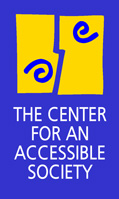
DISABILITY
ISSUES
INFORMATION
FOR
JOURNALISTS
ABOUT
THE CENTER
"Visitability" bill introduced in Congress
The Inclusive Home Design Act, HR 5683, was introduced into Congress by Rep. Jan Schakowsky (D.-Ill.) in October, 2002 and referred to the House Financial Services Committee's Subcommittee on Housing and Community Opportunity.
"It defies logic to build new homes that block people out when it's so easy and cheap to build new homes that let people in," says Schakowsky. To see a copy of the bill, go to http://thomas.loc.gov and type in HR5683.
The bill is the work of a number of disability advocates nationwide, spearheaded by the Disability Rights Action Coalition on Housing, or DRACH, based in Rep. Schakowsky's Illinois district. "We have been successful in passing National Fair Housing Civil Rights Laws, but today's reality is that people with disabilities still don't have the same housing choices as the general population," said DRACH's Karen Tamley, Program Director of Chicago's Access Living independent living center.
"The visitability concept is gaining momentum in small pockets around the country," Schakowsky told Access Living's Gary Arnold. "When we make homes accessible, it benefits not only today's disability community, but also all of us who are friends and family members of a people with disabilities, and it will benefit all of us as we grow old and acquire a disability. A federal law will build on the momentum that has already been created."
More resources on visitability
More about "Visitability"Note to readers: links to news articles may not work after a few weeks, as news media remove current stories to their archives. The link may take you to the archives section, where, for a fee, you can view the article.
"Visitability" is a growing trend nationwide. The term refers to single-family housing designed in such a way that people with disabilities can visit: Basic requirements include
"When someone builds a home, they're not just building it for themselves - that home's going to be around for 100 years," Concrete Change founder Eleanor Smith told The New York Times. "These things hurt nobody -- and they help a lot of other people."
- at least one no-step entrance
- doors and hallways wide enough to navigate through
- a bathroom big enough to get into in a wheelchair, and close the door.
In early 2002, Naperville, Il., and Pima County, AZ made news by passing "visitability" ordinances. But the idea is not a new concept. Since the early 1990s, the grassroots group Concrete Change has promoted the concept through its website at http://concretechange.home.mindspring.com. A number of cities, including Austin, TX and Urbana, IL, now have ordinances that mandate visitability features in single-family housing paid for with public money. Atlanta, the home of Concrete Change and the first city to pass a visitability ordinance, now has over 500 single family homes with vistability features (photo online at http://concretechange.home.mindspring.com/laws.htm). Santa Monica's law, though, would be the first to extend to all new housing. Farther north in California, San Mateo County also encourages visitability (see http://www.smco-cod.org/GraphicPages/ResidentialVisitability.htm).
L. A. Times reporter Bob Poole notes that before Santa Monica's ordinance will become reality, "a major obstacle must be overcome: negative public opinion from those who may fear that liberal Santa Monica is once again taking on a social crusade." Concrete Change members, who are familiar with the arguments, have posted a page of responses at http://concretechange.home.mindspring.com/responses.htm
Athough there's no legal requirement, the U.S. Dept. of Housing and Urban Development "encourages" visitability features in single-family housing built with federal dollars (http://www.huduser.org/publications/pubasst/strategies.html).
Temple University's Institute on Disabilities has information on visitability at http://www.temple.edu/inst_disabilities/iod_nofrm/publications/Accessibility/WhatIsVisitAbility.htm
SUNY/Buffalo maintains a listserv on visitability (with a searchable archive) at http://listserv.acsu.buffalo.edu/archives/visitability-list.html
Read stories about visitability in
The Feb. 6 Arizona Star
The Feb. 7 Chicago Tribune
The Feb. 7 New York Times (registration required)
Resources on "Visitability"More about state and local efforts on visitability can be found on the website of the AARP at http://research.aarp.org/il/inb48_homes.html
Read "On The Outside Looking In: Why Visitability and Universal Design Features Are So Important" by Kim Steele, online at http://www.copower.org/tools/kimhousingtxt.htm Another good article about visitability can be found at the website of the disAbility Resource Center in Everett, Washington. Read disability columnist Mike Ervin's National Public Radio commentary about Concrete Change's Eleanor Smith and Atlanta's visitable homes.
Sign up for a listserv on visitability (or read message archives) at http://listserv.buffalo.edu/archives/visitability-list.html